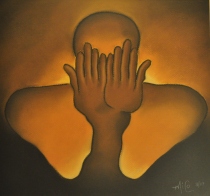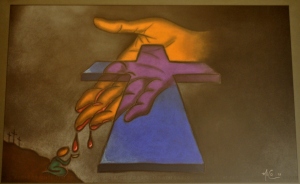Artist Mike Benson just launched micobenson.com displaying his work and thoughts.
Why was Jesus so animated in his reaction to what was going on in the temple that day? Why did he feel compelled to disrupt, to call attention to himself? Was his anger justifiable? And why did he choose to make the temple, the sacred community to which he was called, the very place where he would stage a protest?
These are some of the questions that probe deep at my heart when I reflect upon these passages. Jesus enters the temple and becomes so angry with what he sees that it moves him to begin shouting and overturning tables. He was causing disturbance, and disrupting the status-quo. He claimed that the temple was meant to be a place for welcoming all, a house of prayer, but that it had been reduced to a den of thieves and robbers. This was a harsh claim against the church.
In my reflection on this passage I ask myself what would this act of robbery look like in many of our churches of today? How are we, the Church, robbing and taking from others, turning them away, and driving Jesus into a righteous rage of overturning tables, and disrupting the way we do church?
As an African-American, I have unfortunately witnessed and experienced racial injustice on many of occasions. I can personally attest to the spiritual damage that is done to a person when he is discriminated against, only because the color of his skin is different. I know what it feels like to be part of a community of people who have been historically shunned by a society, a people who have been marginalized, disenfranchised, denigrated, and hated. A people who transcended above these assaults to become survivors.
I have seen the two-facedness of Christians using Christianity as a canopy to discriminate against our sisters and brothers in the churches today, not only because of racial differences, but also because of their gender differences, their sexuality differences, and their theological differences.
This has motivated me as an African-American and a Christian to learn how to see myself the way that I believe Jesus sees. We must learn to love our whole selves, including our “queered” bodies, as they continue to evolve.
Why do we, the Church, often feel threatened and afraid when we encounter bodies that are different in our churches? Why do we look ways to restrain them, to quiet them, to reject their individualities, while we often benefit from their creativity? When we do these things to anyone we deny them basic human rights. We slowly go about finding ways of killing off the Spirit of God that is within each of us.
This is what I name to be a form of “church robbery,” and it continues to drive Jesus into a rage. The passage says that “when the chief priests and the scribes heard what Jesus was teaching, they began looking for ways to kill him, because the whole crowd was spellbound by his teaching.”
I believe that all churches are called to take this prophetic stance of being “table overturners.” We are called to speak out against the forms of injustices that I have named. We must find the courage to hold our churches accountable to the same radical way of loving one another that Jesus often practiced.
As Martin Luther King Jr. stated, “injustice anywhere, is against justice everywhere.” Just as with our Brethren Jesus Christ, there is a cost to this way of discipleship. May we find his bravery, and step up to the calling.








